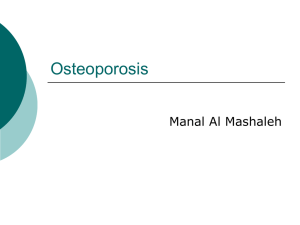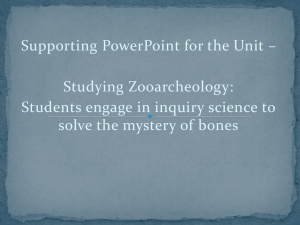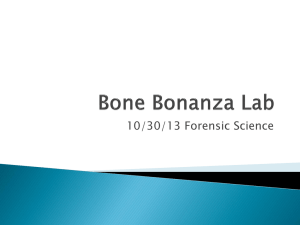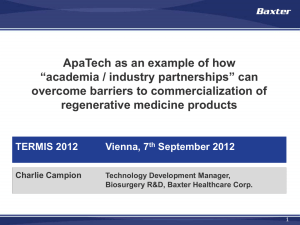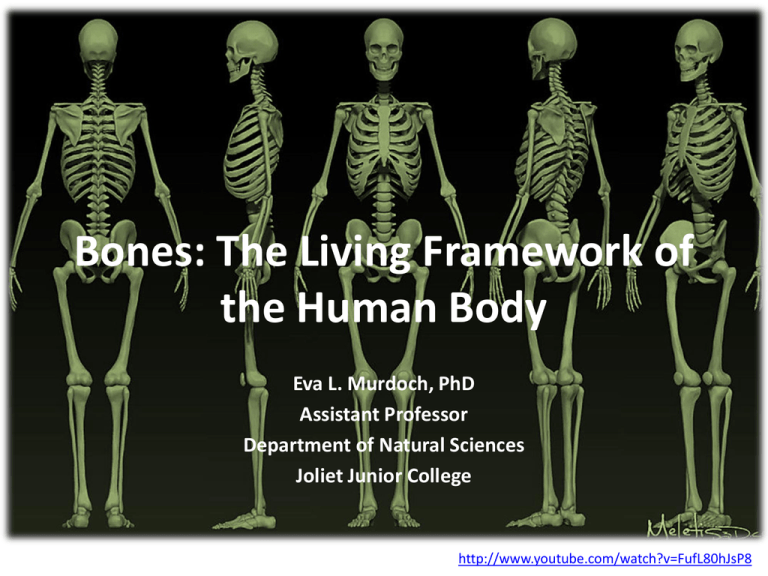
Bones: The Living Framework of
the Human Body
Eva L. Murdoch, PhD
Assistant Professor
Department of Natural Sciences
Joliet Junior College
http://www.youtube.com/watch?v=FufL80hJsP8
The Skeleton
• Provides structural support for the entire body
• Stores minerals
• Protects soft tissues
• Houses red and yellow bone marrow
• Serves as levers, on which skeletal muscles pull
to generate motion
Bone Formation and Growth
• Bone formation
– 6 weeks (embryo 0.5”)
• Bone growth
– Continues during development in utero
– Continues through childhood
– Stops at about age 25
• Hormonal regulation
– Growth hormone & Thyroxin – stimulate bone cells to produce bone
matrix growth
– Sex hormones (estrogen & testosterone) speed up bone synthesis at
puberty growth stops within few years
The Human Body
• The human body: collection of cells and cell
products
- Cells: smallest living unit performing vital functions
- Cell products: non-living, often proteins, also
perform vital functions
Bone Tissue
• Living tissue composed of:
- Several cell types – osteocytes, osteoblasts,
osteoclasts
- Matrix - cell products (collagen fibers) and
inorganic salts (calcium phosphate)
Bone Tissue
• Matrix: Protein-Crystal
Combination:
-
-
Collagen fibers: exceptionally
strong protein, when subjected to
tension – stronger than steel
Calcium phosphate crystals: very
hard, withstanding compression,
but brittle when exposed to
twisting
Ca3(PO4)2
• Bone Cells:
-
Osteocytes: maintain protein and
mineral content of bone matrix
Osteoblasts: produce bone matrix
Osteoclasts: remove and recycle
bone matrix
Bone Tissue
• Bone:
– Strong, somewhat flexible and
highly resistant to shattering.
– On par with the best steelreinforced concrete
– Even better, bone undergoes
changes (remodeling), and can
repair itself after injury
Ca2+
Ca2+
Ca2+
Ca2+
Ca2+
Ca2+
Ca2+
Bone Remodeling
• Maintaining bone mass is a balance between bone cells creating
bone matrix and bone cells dissolving bone matrix.
− Recycle & renewal of bone matrix
– Maintenance of mineral reserve, supply of minerals in body fluids (blood)
− Involves osteocytes, osteoblasts, and osteoclasts
• Turnover rate: varies
− Deposition > removal, bone stronger
− Deposition < removal, bone weaker
• Heavy-metal ion deposition into bone matrix
– Lead (Pb), cobalt (Co), uranium (U), plutonium (Pu)
Bone: Calcium Homeostasis
• Calcium – essential ion for all cells
− Bones: calcium reserve
− Calcium homeostasis: maintenance of
sufficient calcium ion level in blood
1.
Calcium: high in blood
− Calcitonin: decrease of calcium in blood,
resulting in increased bone production
2.
Calcium: low in blood
− Parathyroid Hormone: increase of calcium in
blood, due to an increase in bone breakdown
The Effects of Exercise on Bone
• Bone adapts to physical stress:
– Mineral crystals in bone matrix create small
electrical currents
• Osteoblasts: produce bone matrix
• Electrical currents: repair of severe fractures
– Bone surfaces change
• Thicker, larger bumps & ridges: muscle
attachment
Bone and Aging
• Bone: thinner & weaker
– Osteopenia – b/n ages 30 & 40 women lose
8% of bone mass/decade, men 3%
• Mainly at ends of long bones, vertebrae &
jaws
• Causing fragile limbs, reduction in height,
and tooth loss
– Osteoporosis – age > 45, severe bone loss,
affects: 29% women & 18% man
• Fractures due to normal physical activity
(standing)
• Accelerated in women: loss of estrogen
– Cancer (bone marrow, breast and other) –
risk factor for osteoporosis
• osteoclast activating factors
Normal spongy bone
Things I can do to slow
down the effects of aging
and assure optimum
bone mass.
•
•
•
Spongy bone in osteoporosis
Adequate diet
Weight bearing exercise (daily)
Monitor hormone levels
associated with bone mass



